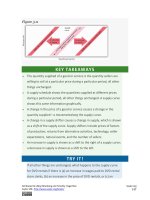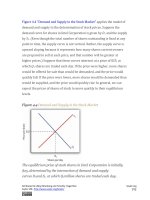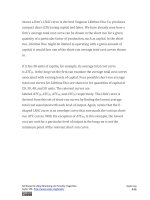Authors libby rittenberg 109
Bạn đang xem bản rút gọn của tài liệu. Xem và tải ngay bản đầy đủ của tài liệu tại đây (383 KB, 1 trang )
2.4 Review and Practice
Summary
Economics deals with choices. In this chapter we have examined more
carefully the range of choices in production that must be made in any
economy. In particular, we looked at choices involving the allocation of an
economy’s factors of production: labor, capital, and natural resources.
In addition, in any economy, the level of technology plays a key role in
determining how productive the factors of production will be. In a market
economy, entrepreneurs organize factors of production and act to
introduce technological change.
The production possibilities model is a device that assists us in thinking
about many of the choices about resource allocation in an economy. The
model assumes that the economy has factors of production that are fixed in
both quantity and quality. When illustrated graphically, the production
possibilities model typically limits our analysis to two goods. Given the
economy’s factors of production and technology, the economy can produce
various combinations of the two goods. If it uses its factors of production
efficiently and has full employment, it will be operating on the production
possibilities curve.
Two characteristics of the production possibilities curve are particularly
important. First, it is downward sloping. This reflects the scarcity of the
factors of production available to the economy; producing more of one
good requires giving up some of the other. Second, the curve is bowed out.
Attributed to Libby Rittenberg and Timothy Tregarthen
Saylor URL: />
Saylor.org
109









